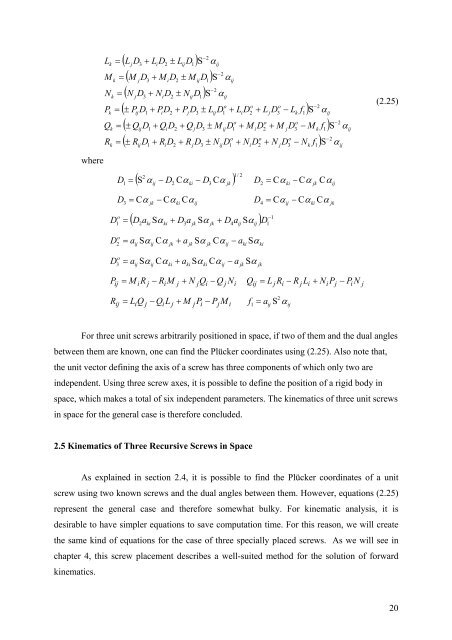Kinematic and Dynamic Analysis of Spatial Six Degree of Freedom ...
Kinematic and Dynamic Analysis of Spatial Six Degree of Freedom ...
Kinematic and Dynamic Analysis of Spatial Six Degree of Freedom ...
You also want an ePaper? Increase the reach of your titles
YUMPU automatically turns print PDFs into web optimized ePapers that Google loves.
where<br />
L<br />
P<br />
k<br />
M<br />
N<br />
k<br />
Q<br />
R<br />
k<br />
k<br />
k<br />
k<br />
=<br />
=<br />
=<br />
=<br />
=<br />
−2<br />
( Lj<br />
D3<br />
+ LiD2<br />
± LijD1<br />
) S αij<br />
−2<br />
( M jD3<br />
+ M iD2<br />
± M ijD1<br />
) S αij<br />
−2<br />
( N jD3<br />
+ NiD2<br />
± NijD1<br />
) S αij<br />
o o o<br />
−2<br />
( ± PijD1<br />
+ Pi<br />
D2<br />
+ Pj<br />
D3<br />
± LijD1<br />
+ LiD2<br />
+ L jD3<br />
− Lk<br />
f1)<br />
S αij<br />
o<br />
o<br />
o<br />
−2<br />
( ± QijD1<br />
+ QiD2<br />
+ Q jD3<br />
± M ijD1<br />
+ M iD2<br />
+ M jD3<br />
− M k f1)<br />
S<br />
o o<br />
o<br />
−2<br />
( ± RijD1<br />
+ RiD2<br />
+ R jD3<br />
± NijD1<br />
+ NiD2<br />
+ N jD3<br />
− Nk<br />
f1)<br />
S αij<br />
=<br />
( ) 2 / 1<br />
2<br />
α − D Cα<br />
− D C<br />
D α<br />
D = Cα<br />
− Cα<br />
Cα<br />
1 = S ij 2 ki 3 jk<br />
2 ki jk ij<br />
D Cα<br />
Cα<br />
Cα<br />
D Cα<br />
Cα<br />
Cα<br />
3 = jk − ki ij<br />
4 = ij − ki jk<br />
−1<br />
( D a Sα<br />
+ D a Sα<br />
+ D a Sα<br />
)<br />
o<br />
D1 2 ki ki 3 jk jk 4 ij ij<br />
= D<br />
o<br />
D2 = aij<br />
Sαij<br />
Cα<br />
jk + a jk Sα<br />
jk Cαij<br />
− aki<br />
Sαki<br />
o<br />
D3 = aij<br />
Sαij<br />
Cα<br />
ki + aki<br />
Sαki<br />
Cαij<br />
− a jk Sα<br />
jk<br />
ij = M iR<br />
j − RiM<br />
j + N jQi<br />
Q j Ni<br />
Qij = L j Ri<br />
− R j Li<br />
+ Ni<br />
Pj<br />
− Pi<br />
N j<br />
P −<br />
R L Q − Q L + M P − P M<br />
ij<br />
= f aij<br />
αij<br />
2<br />
1 = S<br />
i<br />
j<br />
i<br />
j<br />
j<br />
i<br />
j<br />
i<br />
1<br />
α<br />
ij<br />
(2.25)<br />
For three unit screws arbitrarily positioned in space, if two <strong>of</strong> them <strong>and</strong> the dual angles<br />
between them are known, one can find the Plücker coordinates using (2.25). Also note that,<br />
the unit vector defining the axis <strong>of</strong> a screw has three components <strong>of</strong> which only two are<br />
independent. Using three screw axes, it is possible to define the position <strong>of</strong> a rigid body in<br />
space, which makes a total <strong>of</strong> six independent parameters. The kinematics <strong>of</strong> three unit screws<br />
in space for the general case is therefore concluded.<br />
2.5 <strong>Kinematic</strong>s <strong>of</strong> Three Recursive Screws in Space<br />
As explained in section 2.4, it is possible to find the Plücker coordinates <strong>of</strong> a unit<br />
screw using two known screws <strong>and</strong> the dual angles between them. However, equations (2.25)<br />
represent the general case <strong>and</strong> therefore somewhat bulky. For kinematic analysis, it is<br />
desirable to have simpler equations to save computation time. For this reason, we will create<br />
the same kind <strong>of</strong> equations for the case <strong>of</strong> three specially placed screws. As we will see in<br />
chapter 4, this screw placement describes a well-suited method for the solution <strong>of</strong> forward<br />
kinematics.<br />
20
















